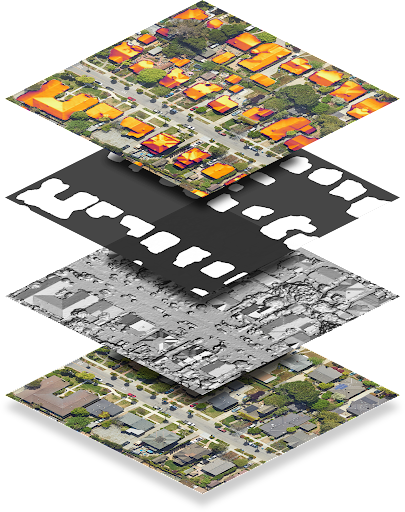
El extremo dataLayers devuelve datos codificados como archivos GeoTIFF, que se pueden usar en cualquier aplicación de sistema de información geográfica (SIG) para diseñar sistemas solares.
Cada cadena de la respuesta de dataLayers contiene una URL que puedes usar para recuperar el archivo GeoTIFF correspondiente. Las URLs son válidas hasta una hora después de que se generan a partir de la solicitud original de la capa de datos. Los archivos GeoTIFF se pueden almacenar durante un máximo de 30 días.
Con la excepción de la capa RGB, los archivos GeoTIFF no se muestran correctamente con un visor de imágenes, ya que el contenido son datos codificados en lugar de imágenes RGB. Los archivos GeoTIFF tampoco se pueden usar directamente como una imagen de superposición con la API de Maps JavaScript.
En la siguiente tabla, se describe cada capa en detalle.
| Capa | Profundidad de píxel | Solución | Descripción |
|---|---|---|---|
| Modelo de superficie digital (DSM) | Número de punto flotante de 32 bits | 0.1 m/píxel | Son datos de elevación que representan la topografía de la superficie de la Tierra, incluidas las características naturales y las construidas. Los valores están en metros sobre el nivel del mar. Las ubicaciones no válidas o las áreas en las que no tenemos datos se almacenan como -9999. |
| RGB | De 8 bits | 0.1 m/píxel 0.25 m/píxel |
Una imagen aérea o satelital de la región El archivo de imágenes GeoTIFF contiene tres bandas que corresponden a los valores de rojo, verde y azul para formar un valor RGB de 24 bits para cada píxel. De forma predeterminada, la resolución de píxeles es de 0.1 m/píxel. |
| Máscara de compilación | 1 bit | 0.1 m/píxel | Un bit por píxel que indica si ese píxel se considera parte de un techo. |
| Flujo anual | Número de punto flotante de 32 bits | 0.1 m/píxel | Mapa de flujo anual, o luz solar anual en los techos, de la región.
Los valores son kWh/kW/año. El flujo se calcula para cada ubicación, no solo para los techos de los edificios. Las ubicaciones no válidas o las áreas en las que no pudimos calcular el flujo se almacenan como -9999. Las ubicaciones fuera de nuestra área de cobertura no son válidas. Nota: Este es el flujo sin máscara. |
| Flujo mensual | Número de punto flotante de 32 bits | 0.5 m/píxel | Es el mapa de flujo mensual (luz solar en los techos, desglosado por mes) de la región. Los valores son kWh/kW/año. El archivo de imágenes GeoTIFF contiene 12 bandas correspondientes a los meses de enero a diciembre, en orden. |
| Sombra por hora | Número entero de 32 bits | 1 m/píxel | 12 URLs para los mapas de sombra por hora correspondientes a los meses de enero a diciembre, en orden. Cada archivo GeoTIFF contiene 24 bandas, que corresponden a las 24 horas del día. Cada píxel es un número entero de 32 bits que corresponde a los (hasta) 31 días de ese mes. Un 1 bit significa que la ubicación correspondiente puede ver el sol ese día, a esa hora y en ese mes. Las ubicaciones no válidas se almacenan como -9999 y tienen establecido el bit 31, ya que corresponde al día 32 del mes y, por lo tanto, no es válido. |
Decodifica rásteres de sombra por hora
Los datos de sombra por hora se codifican en rásteres multibanda. Para obtener más información sobre los conceptos básicos de los rásteres, consulta Conceptos de la API de Solar.
Cuando realizas una solicitud de datos de sombra por hora, puedes recibir hasta 12 rásteres, uno para cada mes del año calendario (de enero a diciembre). Cada ráster se compone de 24 capas o bandas, que corresponden a las 24 horas del día.
Cada banda se representa con una matriz de celdas o píxeles. Cada píxel tiene una profundidad de 32 bits, que corresponden a los 31 días (máximos) del mes. Por lo tanto, para decodificar el día, la hora y el mes de los datos de sombra, es necesario comprender el bit, la banda y el ráster que se analizan.
Por ejemplo, para identificar si una ubicación determinada en las coordenadas (x, y) vio el sol a las 4 p.m. del 22 de junio, haz lo siguiente:
- Realiza una solicitud de capas de datos para todas las capas de la ubicación (x, y).
- Como junio es el sexto mes del año, recupera la sexta URL de la lista
hourlyShadeUrls. - Los intervalos horarios se indican en formato de 24 horas. Para obtener datos de las 4 p.m. (16:00), busca el canal 17.
- Índice de bits (días) a partir de 0. Para obtener los datos del 22º día de junio, lee el bit 21.
- Los bits proporcionan datos binarios que indican si esa ubicación vio el sol en la fecha y hora determinadas. Si el bit es 1, significa que la ubicación vio el sol. Si el bit es 0, la ubicación vio sombra.
El siguiente código resume los pasos anteriores:
(hourly_shade[month - 1])(x, y)[hour] & (1 << (day - 1))

